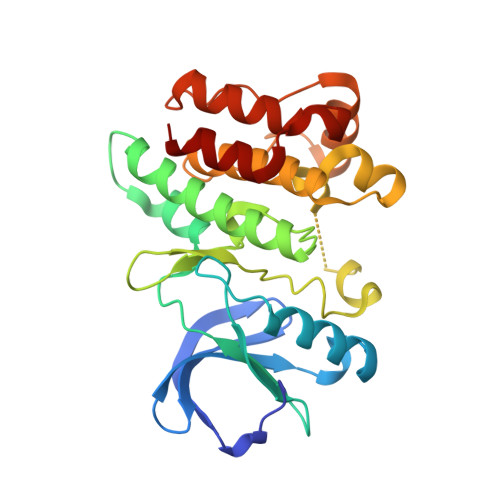Small molecule inhibitors reveal PTK6 kinase is not an oncogenic driver in breast cancers.
Qiu, L., Levine, K., Gajiwala, K.S., Cronin, C.N., Nagata, A., Johnson, E., Kraus, M., Tatlock, J., Kania, R., Foley, T., Sun, S.(2018) PLoS One 13: e0198374-e0198374
- PubMed: 29879184
- DOI: https://doi.org/10.1371/journal.pone.0198374
- Primary Citation of Related Structures:
6CZ2, 6CZ3, 6CZ4 - PubMed Abstract:
Protein tyrosine kinase 6 (PTK6, or BRK) is aberrantly expressed in breast cancers, and emerging as an oncogene that promotes tumor cell proliferation, migration and evasion. Both kinase-dependent and -independent functions of PTK6 in driving tumor growth have been described, therefore targeting PTK6 kinase activity by small molecule inhibitors as a therapeutic approach to treat cancers remains to be validated. In this study, we identified novel, potent and selective PTK6 kinase inhibitors as a means to investigate the role of PTK6 kinase activity in breast tumorigenesis. We report here the crystal structures of apo-PTK6 and inhibitor-bound PTK6 complexes, providing the structural basis for small molecule interaction with PTK6. The kinase inhibitors moderately suppress tumor cell growth in 2D and 3D cell cultures. However, the tumor cell growth inhibition shows neither correlation with the PTK6 kinase activity inhibition, nor the total or activated PTK6 protein levels in tumor cells, suggesting that the tumor cell growth is independent of PTK6 kinase activity. Furthermore, in engineered breast tumor cells overexpressing PTK6, the inhibition of PTK6 kinase activity does not parallel the inhibition of tumor cell growth with a >500-fold shift in compound potencies (IC50 values). Overall, these findings suggest that the kinase activity of PTK6 does not play a significant role in tumorigenesis, thus providing important evidence against PTK6 kinase as a potential therapeutic target for breast cancer treatment.
Organizational Affiliation:
Center of Therapeutic Innovation, Pfizer Inc., New York, NY, United States of America.















